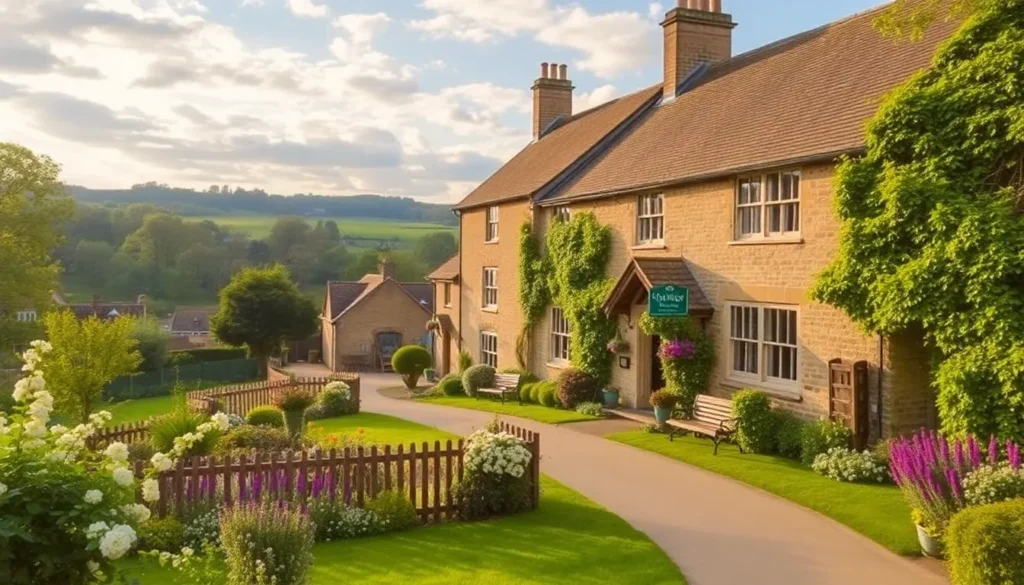Travel Tips for Visiting the Cotswolds Successfully

- Understanding the Cotswolds: Location and Accessibility
- Travel Documentation: What You Need to Know
- Renting a Car: Your Key to Exploring the Cotswolds
- The Best Time to Visit the Cotswolds
- Must-See Attractions in the Cotswolds
- Planning Your Itinerary: How Many Days to Spend in the Cotswolds
- Accommodation Options in the Cotswolds
- Dining in the Cotswolds: What to Expect
- Budgeting for Your Cotswolds Trip
- Currency and Money Tips for Your Cotswolds Trip
- Additional Tips and Recommendations for Visiting the Cotswolds
Dreaming of a getaway to the enchanting English countryside? If the picturesque villages, rolling hills, and serene landscapes of the Cotswolds beckon you, you're in for a treat! This guide is packed with essential tips and insights that will help you navigate this stunning region like a pro.
The Cotswolds is often described as a step back in time. Here, charming limestone cottages adorned with vibrant gardens dot the landscape, and the air is filled with the scent of blooming flowers. It's a place where you can unwind, breathe deeply, and indulge in the simple pleasures of rural life. But before you pack your bags and head for a delightful cup of tea at five o'clock, let's delve into some crucial advice for your trip to the Cotswolds. What’s the best time to visit? Should you rent a car? Which villages are must-sees? Let’s find out!
Understanding the Cotswolds: Location and Accessibility
The Cotswolds is a stunning region located in south-western England, known for its breathtaking landscapes characterized by gentle hills and quaint, honey-colored stone villages. It spans across several counties, including Gloucestershire, Oxfordshire, Warwickshire, Wiltshire, and Worcestershire.
This area is conveniently situated near major cities like London, Birmingham, and Bristol, making it an ideal escape from urban life. The region stretches from the picturesque meadows of the upper Thames River in the east to the rugged terrain overlooking the Severn Valley in the west.
To start your journey in the Cotswolds, the primary gateway is Bristol Airport (BRS), located about 30 miles (45 km) from Castle Combe. Numerous low-cost airlines, including Ryanair and EasyJet, operate flights from various European cities, including Barcelona, Madrid, and Málaga.
If you're arriving from Birmingham, Birmingham Airport (BHX) also provides affordable options and connections from several Spanish cities. Lastly, London airports are a viable option, with a travel time of approximately 2.5 hours to the Cotswolds, allowing you to combine a London visit with your Cotswolds adventure.
For the best flight deals, we recommend using Skyscanner.
Travel Documentation: What You Need to Know
In light of Brexit, traveling to the UK has changed slightly. It's essential to carry a valid passport and apply for an online ETA (Electronic Travel Authorization) prior to your trip, which costs £16. If you are traveling from outside Europe, an ETA is typically your only requirement, but checking the UK immigration website is a smart move.
With the end of free roaming, be aware that your mobile service provider may charge fees for using your phone in the UK. Some telecom companies offer special travel rates, so consider checking for options that suit your needs. For more information on staying connected, check out our guide on internet in the UK.
Renting a Car: Your Key to Exploring the Cotswolds
One of the best ways to experience the Cotswolds is by renting a car. While the thought of driving on the left side may be intimidating at first, the freedom and flexibility a car provides are unparalleled. You can create a personalized itinerary and visit hidden gems at your own pace.
Driving through the Cotswolds is a visual treat, with scenic routes winding through lush hills and charming villages. Public transport options are limited and often do not reach all the quaint spots. By renting a car, you ensure that you won't miss out on the region's captivating beauty.
⭐ We used Auto Europe to rent our car through Green Motion. For five days, we paid around €150, including comprehensive insurance. We had a daily mileage limit of 100 miles, which turned out to be more than sufficient for our adventures.
Parking in the Cotswolds: What to Expect
In smaller villages and less touristy areas, parking is generally free. However, in more popular towns such as Broadway and Bath, expect to pay for parking. It’s a good idea to plan your parking options ahead of time and mark them on Google Maps to save time.
Most parking meters accept cards, but some only take coins, so it’s wise to have some change on hand. You can also use apps like RingGo or MiPermit to pay for parking. We attempted to register for these but faced issues due to not having a local number.
Another helpful app is AppyParking, which can find you both free and paid parking across the UK. Additionally, our blog post outlines parking spots in each village, making it easier for you to navigate.
Public Transport: Alternatives for Exploring the Cotswolds
If renting a car isn't an option, you can still explore the Cotswolds using public transport, though planning is crucial. The Explore the Cotswolds website provides information on bus routes connecting various villages, but coverage is not comprehensive.
For a more convenient option, consider the Cotswolds Discoverer Pass, which allows unlimited travel on trains and buses in the area for £13. For those looking for a guided experience, various day trips from London, such as visits to the Cotswolds and Blenheim Palace, are available, which includes transport and a guide.
The Best Time to Visit the Cotswolds
The Cotswolds experiences a mild and damp climate year-round, with the summer being the prime season for visiting due to the pleasant weather. Spring and early autumn (May-June and September-October) are also lovely times, albeit with a higher chance of rain. If you don’t mind a bit of chill, autumn offers stunning foliage and a cozy atmosphere.
We visited in late August during a bank holiday, and the weather was delightful. Keep an eye on public holidays, as they can affect availability and prices. Major holidays include:
- Good Friday and Easter Monday (March-April)
- Early May bank holiday (first weekend of May)
- Spring bank holiday (May-June)
- Summer bank holiday (late August)
Must-See Attractions in the Cotswolds
Here are our top 10 must-visit locations in the Cotswolds:
- Castle Combe, often heralded as England's prettiest village.
- Bourton-on-the-Water, a unique village traversed by a serene canal.
- Bibury, famous for its picturesque Arlington Row.
- Ruins of Minster Lovell Hall and Dove, a perfect picnic spot.
- Blenheim Palace, the grand estate where Winston Churchill was born.
- Sudeley Castle with its beautiful gardens.
- A scenic hike to Broadway Tower for breathtaking views.
- Lacock Abbey, known for its stunning medieval cloister.
- Stratford-upon-Avon, Shakespeare’s birthplace; discover what to see here.
- Bath, an ancient Roman spa town with lively ambiance.
- Extra: A quick detour to Stonehenge if time allows.
⭐ Check out these essential attractions that you can’t miss!
Keep in mind that some popular sites require an entry fee, including:
- Blenheim Palace + gardens: £35
- Sudeley Castle: £19.50
- Lacock Abbey: £19
- Stonehenge (there's a free viewing path): £23-29
- Shakespeare's Birthplace in Stratford-upon-Avon: £18
Understanding the National Trust's Touring Pass
The National Trust is a charitable organization dedicated to preserving the UK’s natural and historical heritage. They offer a Touring Pass for foreign visitors, valid for 7 or 14 days, granting access to over 300 sites for a single fee. However, many popular attractions in the Cotswolds are not part of the National Trust, but locations like Lacock Abbey and Dyrham Park are included.
The pass prices are as follows (7 days / 14 days):
- Individual: £41 / £47
- Couple: £71 / £84
- Family (2 adults and 2 children): £78 / £99
→ More details about the Touring Pass.
Exploring the Cotswolds on Foot: Hiking Opportunities
The Cotswolds is a haven for hiking enthusiasts. The famous Cotswolds Way is a 102-mile trail that traverses the region, offering breathtaking scenery and varied terrain. It can be tackled in segments based on your preference.
If you're looking for shorter hikes, consider these popular routes:
- Climbing to Broadway Tower from the village.
- Wandering through the woods at Crickley Hill.
- Hiking up Leckhampton Hill.
- Summiting Cleeve Hill.
- Walking to Minster Lovell Hall for a refreshing swim (don’t forget your swimsuit).
- Exploring the meadows around Stanton.
Scenic Viewpoints in the Cotswolds
While there are no towering mountains, the gentle hills in the Cotswolds offer stunning panoramic views of the picturesque landscape. The best time to visit these viewpoints is during sunset for an unforgettable experience.
Consider visiting these popular lookout points:
- Painswick Beacon
- Crickley Hill
- Cleeve Hill, near a Neolithic long barrow (Belas Knap)
Planning Your Itinerary: How Many Days to Spend in the Cotswolds
The Cotswolds is not a vast area, so you can comfortably explore the charming villages in about 2 to 3 days. However, there are numerous attractions just beyond the region, such as Stratford-upon-Avon, Stonehenge, and the cities of Oxford, Bath, and Bristol.
We spent a total of 5 days (4 nights) and explored the following itinerary:
- Day 1: Castle Combe and Cirencester.
- Day 2: Bibury, Bourton-on-the-Water, Lower and Upper Slaughter, Stow-on-the-Wold, Broadway, and Snowshill.
- Day 3: Stratford-upon-Avon, Chipping Campden, Moreton-in-Marsh, Stow-on-the-Wold, Stanton, Winchcombe, and Sudeley Castle.
- Day 4: Burford, Minster Lovell Hall, Blenheim Palace, and sunset at Castle Combe.
- Day 5: Lacock, Stonehenge, and Bath.
⭐ For more detailed itineraries, check out our guide on 3, 4, and 5-day routes in the Cotswolds.
Accommodation Options in the Cotswolds
When searching for accommodation in the Cotswolds, don’t limit yourself to the most popular villages, as options tend to be scarce and pricey. The region is compact, and distances between attractions are short, so consider looking for places slightly away from the main attractions for better quality and affordability.
If you uncover a great deal in charming villages like Castle Combe, Bourton-on-the-Water, or Broadway, consider yourself lucky! You might also find lovely hotels in historic mansions that offer a unique experience. While these may be pricier, they often provide better value for the quality.
We chose to switch accommodations during our stay but are also happy to recommend staying in a centrally located hotel if you find one that meets your needs. Here are some of the accommodations we enjoyed:
› The Barrel Store (Cirencester): A cozy hostel with private rooms and shared bathrooms located in the largest town in the Cotswolds. We were pleasantly surprised and would return! 1 night: €65.
› The Northwick Arms Hotel (Evesham): A spacious and comfortable room, although cleanliness could be improved. The village itself is unremarkable. Not our first choice, but it was the best option available when booking late. 2 nights: €168.
› The Stanton Manor (near Castle Combe): The highlight of our stay, this beautiful manor with charming gardens is just a short distance from Castle Combe. We would gladly return. 1 night: €92.
Dining in the Cotswolds: What to Expect
Dining in the Cotswolds can be a delightful experience, but be prepared to spend a bit more. On average, expect to pay around £15 per dish, though there are both cheaper and more expensive options available.
Fortunately, many pubs and restaurants offer lunch deals during weekdays, which typically include an appetizer and a main course for around £10-14. It’s also common to request tap water instead of bottled drinks, saving you some money.
If your visit falls on a Sunday, don’t miss the opportunity to enjoy a traditional Sunday roast, featuring local favorites. We had ours at the Crown pub in Broadway, where reservations are advisable!
⭐ For more recommendations on where to eat well and affordably, check out our guide!
Budgeting for Your Cotswolds Trip
A trip to the Cotswolds is not as budget-friendly as a weekend at your parents’ home with cheap drinks. Generally, traveling in England, especially in this region, can be quite pricey. However, with a little planning and the tips provided, you can mitigate costs.
Here’s a breakdown of a basic budget for a 5-day trip:
⭐ For a detailed view of expenses, check our article on how much it costs to travel in the Cotswolds.
Flights → €100
Car rental + fuel → €110
Accommodation → €160
Food → €175
Attractions → €50
Miscellaneous → €25
TOTAL → €620
Currency and Money Tips for Your Cotswolds Trip
Remember that the official currency in England is the pound sterling (£). If you use your regular cards to withdraw cash or make payments, be aware of potential fees ranging from 2% to 4%.
It’s beneficial to acquire a card that offers traveler-friendly conditions. We recommend the Revolut card, which currently offers a bonus of €10 for new users. If you prefer to keep things simple, you can take some cash and exchange it once you arrive, although it’s best to avoid airport exchange services due to poor rates.
Additional Tips and Recommendations for Visiting the Cotswolds
Before you head off, here are some quick yet valuable tips:
- The plug type in England is G (with three rectangular prongs), so you’ll need an adapter. Hotels usually don’t provide them, so it’s wise to purchase one beforehand (a universal adapter is recommended).
- Consider getting travel insurance to avoid any unwanted surprises. Iati Escapadas is suitable for short trips and costs about €20, plus you can get a 5% discount through this link.
- Did you know you can visit Stonehenge for free? If you’re on a budget and want to save the approximately €30 entry fee, there’s a free path that offers similar views as the paid route.
- The same goes for Blenheim Palace. If you’re only interested in viewing it from the outside, head to this access point at the park’s back, where you can walk to the palace in about 20 minutes. Just a heads up—there are only a couple of parking spaces on the road.
- The Cotswolds once thrived as a prominent wool trade area in Europe. If you’re looking for a souvenir, consider purchasing a wool sweater. The region is also known for its vintage shops, particularly in Tetbury and Stow-on-the-Wold.
- Bring a rain jacket as the area tends to experience rain (though we only had a bit of drizzle). Even in summer, pack layers, as temperatures can stay around 20 degrees.
We’ve reached the end of our guide on tips for traveling to the Cotswolds! If you have any questions, feel free to leave a comment. If you’re considering a trip to this area of England, book your flights now—it's truly a marvelous destination, perfect for road trips!
| Save on your trip |
| Compare and find cheap flights here |
| Find accommodation at the best prices here |
| Reserve activities and tours in Spanish here |
| Get a €10 gift by booking transport in Europe here |
| 5% off your travel insurance with IATI here |
| Book airport transfers here |
| Learn how to withdraw money without fees here |
| Get a 5% discount on your eSIM from Holafly here |
| Rent a car with the best deals here |
| Compare prices on van rentals here |
| The best books and travel guides here |
| All our articles about England |





Deja una respuesta